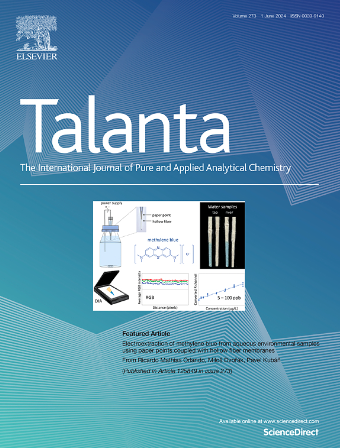一种基于吡啶蛋白的“共价组装”荧光探针,用于在纯水介质和实际水样中敏感检测氰化物。
IF 6.1
1区 化学
Q1 CHEMISTRY, ANALYTICAL
引用次数: 0
摘要
为了实现对水环境基质中致命氰化物离子的高效反应荧光传感,我们合理设计了基于“共价组装”原理的荧光探针,并在这种亲核分析物的辅助下进行了分子内交叉苯甲酸反应。设计了一种独创的合成路线,用于研制这种史无前例的水溶性荧光氰化物反应化学剂量计。这种“共价组装”探针的独特结构特征使其能够通过氰化物阴离子引发的与水相容的多米诺骨牌反应,轻松转化为绿黄色发射pyronin (λmax Ex/Em 535/ 556nm,在中性缓冲水溶液中ΦF = 61%),从而产生强烈的“开启”荧光响应。一组不同的基于荧光的测定强调了该探针的传感性能,特别是它能够通过用户友好的便携式荧光计检测磷酸盐缓冲液中100-200 nmol/L范围内的低浓度氰化物离子。从实际的角度来看,我们已经证明这种传感策略在实际水样中也有效,从而产生1-2 μmol/L的检测限(LOD)范围,符合世界卫生组织的建议。此外,目前的pyronin笼前体检测内源性氰化物离子在一个真正的食物样品(新鲜切木薯片)的能力也得到了证实。因此,这项研究是在基于荧光的环境和食品安全分析中普及“共价组装”探针概念的重要一步,迄今为止,这一概念在很大程度上尚未得到充分探索。本文章由计算机程序翻译,如有差异,请以英文原文为准。

A pyronin-based “covalent-assembly” fluorescent probe for sensitive detection of cyanide in pure aqueous media and real water samples
In order to achieve efficient reaction-based fluorogenic sensing of lethal cyanide ions in aqueous environmental matrices, we have rationally designed a fluorescent probe based on the “covalent-assembly” principle and an intramolecular crossed-benzoin reaction assisted by this nucleophilic analyte. An original synthetic route towards this unprecedented water-soluble fluorescent cyanide-responsive chemodosimeter was devised. The unique structural features of this “covalent-assembly” probe enable its facile conversion into a green-yellow emissive pyronin (λmax Ex/Em 535/556 nm, and ΦF = 61 % in neutral buffered aqueous solution) through a water-compatible domino reaction triggered by cyanide anion, thus producing a strong “turn-on” fluorescence response. A set of different fluorescence-based assays have highlighted sensing performances of this probe, especially its ability to detect low concentrations of cyanide ions in phosphate buffer within the range of 100–200 nmol/L, by means of a user-friendly portable fluorometer. From a practical point of view, we have shown that this sensing strategy was also effective in real water samples, thus producing a limit of detection (LOD) range of 1–2 μmol/L in line with World Health Organization recommendations. Furthermore, the capability of the present pyronin caged precursor to detect endogenous cyanide ions in a real food sample (freshly cut cassava slices) was also confirmed. This study is thus an important step towards the popularization of the concept of “covalent-assembly” probes in fluorescence-based environmental and food safety analyses, largely under-explored until now.
求助全文
通过发布文献求助,成功后即可免费获取论文全文。
去求助
来源期刊

Talanta
化学-分析化学
CiteScore
12.30
自引率
4.90%
发文量
861
审稿时长
29 days
期刊介绍:
Talanta provides a forum for the publication of original research papers, short communications, and critical reviews in all branches of pure and applied analytical chemistry. Papers are evaluated based on established guidelines, including the fundamental nature of the study, scientific novelty, substantial improvement or advantage over existing technology or methods, and demonstrated analytical applicability. Original research papers on fundamental studies, and on novel sensor and instrumentation developments, are encouraged. Novel or improved applications in areas such as clinical and biological chemistry, environmental analysis, geochemistry, materials science and engineering, and analytical platforms for omics development are welcome.
Analytical performance of methods should be determined, including interference and matrix effects, and methods should be validated by comparison with a standard method, or analysis of a certified reference material. Simple spiking recoveries may not be sufficient. The developed method should especially comprise information on selectivity, sensitivity, detection limits, accuracy, and reliability. However, applying official validation or robustness studies to a routine method or technique does not necessarily constitute novelty. Proper statistical treatment of the data should be provided. Relevant literature should be cited, including related publications by the authors, and authors should discuss how their proposed methodology compares with previously reported methods.
 求助内容:
求助内容: 应助结果提醒方式:
应助结果提醒方式:


